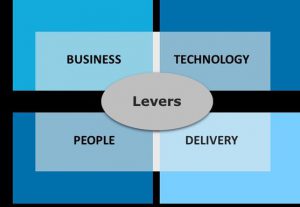WHY SWITCHING FROM PROCESS TO DATA DRIVEN APPROACH IN RAILWAYS DOMAIN?
October 3, 2018
03According to UNIFE,
“the rail sector faces huge challenges. New competitors coming from Asia shake historical European leadership, and the rail industry must improve its competitiveness continuously. Competitive modes of transport (e.g. low-cost airlines or buses) are becoming a credible alternative to main-lines transport. Furthermore, the increasing success of new business models (e.g. Uber, BlablaCar) is changing the roles and the positions of the stakeholders in the mobility landscape. And the needs of the citizens are also drastically changing, with commuting mobile apps, real-time information which become part of the everyday life and which conduct the passengers to ask for the same level of services for their end-to-end journey. UNIFE has identified at least six disruptive trends that the transport sector will have to master.” (see the white paper: 20160913_Digital_Position paper final UNIFE” Based in Brussels since 1992, UNIFE is the association representing the European rail supply industry at the EU and international level. UNIFE gathers over 85 direct company Members product to another before the change, to perform the change itself in under one minute. http://www.unife.org/). Anyway, the transport sector will not escape the digital race and the final user does not care who will provide the service. He just wants the premium.”
Obviously, New challenges are tougher than ever….
As a matter of fact, gathering all “correct information” coming from heterogeneous data sources in order to “simplify” the life of the End User is really challenging and sharing in a full duplex way all data will have to be mastered in order to manage nominal mode and all “exceptions” as well.
In fact, the quality of the service will certainly be evaluated regarding the way that it will be delivered in degraded conditions (accident, strikes, any exceptional event…). That means that this will reinforce two aspects to work on :
- How to guarantee a regular service level, however, the system is running?
- How to minimize the learning curve?
- What kind of smart contracts I will have to negotiate?
- How confident will I be with data use?
- As a transport operator, what will be the impact on my operations?
It is clearly a transformation where manufacturers, operators, and maintainers involved in this sector are all working on the way to create a momentum around Data & IoT for their clients and the clients of their clients. For all companies, the goal is always to speed up the improvement of efficiency and productivity and provide the employees, engineers, and technicians with the best tools based on digital capabilities.
Data processing and new approach including machine learning and artificial intelligence algorithm are key to be different and provide the market with new services and new smart products.
A Data-driven platform based on reliable information coming from outside, machines and infrastructures is clearly the best way to think about the transport of the future and fits completely with the needs of (re)invent it.
The same technology and architecture can serve both:
- Passenger expectations;
- Regulatory requirements;
- Digital Manufacturing issues & Internal operation process (for instance preventive and predictive maintenance).
But collecting data from a single source, machine … and its immediate environment to feed optimization algorithms is one thing, collecting data from a complete environment is a very different endeavor. One potentially needs to aggregate and analyze data, not only from disparate equipment but as well production tracking systems and even enterprise applications. Automation/Operation Technology is a world dominated by specific and proprietary standards, making it difficult to extract data from.
Working closely with our customers and our partners, we have identified 4 levers to tackle these concerns:
Business:
- Provide a rich Ecosystem composed of strategic alliances, specific partnership, and start-up emerging networks.
- Analyze the impact on business process re-engineering
- Help to speed up ideation and experimentation process
- Co-define different Business Model and way to monetize new service offerings
People:
- Analyze the impact on business process
- Minimize the learning curve if needed sharing the return on experiences and provide the right level of multi-disciplinary expertise
- Stress on “make or buy” solutions mindset
- Accompany in the change Management to reduce the gap between IT and OT approaches
Technology:
- Accelerate Data platform design and built with “plug & play” solutions
- Monitor emerging technologies (things and network) to facilitate anticipation & Impact on IoT based on industrial standards
- Help to provide with “secured by design” solutions
Delivery:
- Mobilize assets and capabilities to scale up and industrialize faster
- Take benefit of the build phase to an instrument and anticipate the “run phase”
- Coordinate partners to create a momentum during projects and make expertise available
- Secure the project and the product with ad hoc organization
The balance between these four levers is essential to achieve the objectives and succeed and nothing really new under the sun when you decide to investigate a new domain or a new way of working but often forgotten.

 English | EN
English | EN 
